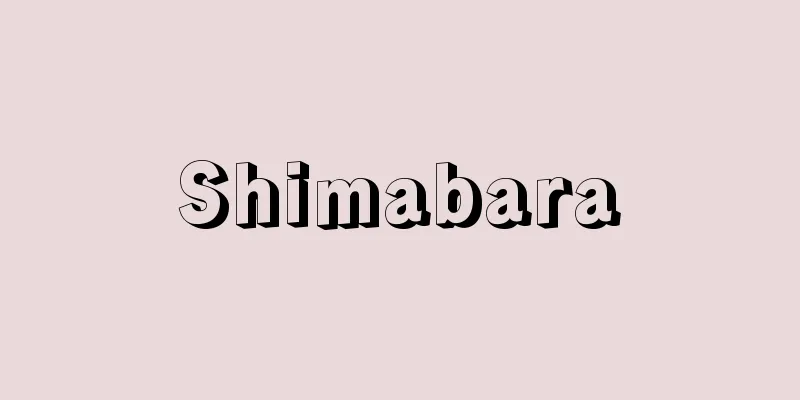Shimabara

|
Located in Shimogyo Ward, Kyoto City, this area was once a brothel. It is located east of Tanbaguchi Station on the Sanin Main Line, and consists of Kaminocho, Shimonocho, Tayucho, and Ageyacho. In 1640 (Kan'ei 17), Kyoto Shoshidai Itakura Shigemune ordered the brothel located in Rokujo Misujicho (Yanagimachi) to be relocated to this area on the outskirts of the town, and it was the only officially licensed pleasure quarter in Kyoto throughout the Edo period. The official name of the area is Nishishin-yashiki, but it is said to have been called Shimabara because the shape of the brothel resembled Shimabara Castle (Nagasaki Prefecture), or because the order to relocate was so sudden that the chaotic situation resembled the Shimabara Rebellion. Shimabara was the first fully-fledged brothel, with a moat dug around the perimeter of an area of about 220 meters (2 cho) and a single entrance at the Somon gate. From its establishment, it prospered until the Genroku period (1688-1704), but its distinctive feature was the entertainment of the tayu (commonly known as kottai) in the brothels. After that, due to economic and geographical conditions, as well as the adherence to formality and the decline in the quality of prostitutes, it was pushed aside by the power of private prostitutes in Gion, Nijo, Shichijo, and Kitano. Some private prostitutes were forcibly confined to Shimabara as a result of crackdowns, but it could no longer keep up with the times, and it suffered a decisive blow in the summer of 1854 (Kaei 7). After the Meiji Restoration, old customs such as the Tayu Dochu procession through the Kuruwa every April were revived, but the center of entertainment in Kyoto had already shifted to Gion. Nevertheless, it continued to exist as a brothel until the Anti-Prostitution Law came into force in 1958 (Showa 33). Remaining buildings include the ageya-style Sumiya (a nationally designated Important Cultural Property, now the Sumiya Motenashi Cultural Museum), Matsumotoro, the okiya Wachigaiya, and Daimon (Wachigaiya and Daimon are registered cultural properties designated by Kyoto City). [Takeo Oda and Yoichi Harashima] Painting by Hasegawa Sadanobu (first generation) National Diet Library "Famous Places in the Capital: Scenery from the Shimabara Exit" " Famous Places of Kyoto" (1907, Meiji 40) owned by the National Diet Library The Shimabara Tayuu Procession Source: Shogakukan Encyclopedia Nipponica About Encyclopedia Nipponica Information | Legend |
|
京都市下京区にある、もと遊廓(ゆうかく)のあった地。山陰本線丹波口(たんばぐち)駅の東に位置し、上之町(かみのちょう)、下之町(しものちょう)、太夫(たゆう)町、揚屋(あげや)町などからなる地域。1640年(寛永17)、京都所司代板倉重宗(しげむね)により、六条三筋町(柳町)にあった遊廓を町はずれのこの地へ移転するように命じられ、以後、江戸時代を通じ京都で唯一の公許の遊里であった。西新屋敷(にししんやしき)が公式地名であるが、島原とよぶのは、遊廓の形が島原城(長崎県)に似ていたからとも、移転命令が急でその混乱状態が島原の乱のようであったからともいう。島原は、約2丁(220メートル)四方の周囲に溝を掘り、出入りは惣門(そうもん)の一方口とする本格的遊廓の最初のものであった。設立以来、元禄(げんろく)年間(1688~1704)までは繁栄したが、その特色は太夫(コッタイと俗称)の揚屋遊びにあった。その後、経済的・地理的条件に加えて、格式の墨守や妓品(ぎひん)の下落などのため、祇園(ぎおん)・二条・七条・北野の私娼(ししょう)勢力に押された。取締りによって私娼の一部が島原へ強制収容されることもあったが、もはや時流に添えず、さらに1854年(嘉永7)夏の大火によって決定的な打撃を受けた。明治維新後、毎年4月に廓(くるわ)内を行列して歩く太夫道中などの旧習を復活したが、すでに京都の遊興の中心は祇園に移っていた。それでも、1958年(昭和33)売春防止法施行までは遊廓として存続した。揚屋建築の角屋(すみや)(国指定重要文化財、現在は角屋もてなしの文化美術館)、松本楼、置屋の輪違屋(わちがいや)、大門(輪違屋と大門は京都市指定登録文化財)などが残っている。 [織田武雄・原島陽一] 長谷川貞信(初世)画国立国会図書館所蔵"> 『都名所之内 島原出口光景』 『京都名勝』(1907年〈明治40〉)国立国会図書館所蔵"> 島原の太夫道中 出典 小学館 日本大百科全書(ニッポニカ)日本大百科全書(ニッポニカ)について 情報 | 凡例 |
>>: Shimabara [city] - Shimabara
Recommend
Courrèges, A.
…Introduced by the British designer Mary Quant in...
Pānini - Pānini (English spelling)
Date of birth and death unknown. A famous grammar...
Alonso, Alicia
Born: December 21, 1920, Havana [Died] October 17,...
Collection of Cloud Songs - Yun-yao-ji
A collection of poems from the Tang Dynasty in Chi...
Battle of Aonogahara
In 1338 (Engen 3/Ryakuo 1), the Southern Court arm...
Philonotis thwaitesii
...Young capsules are green and spherical, while ...
Ishiguro Sanso - Ishiguro Sanso
...A manor in Tonami County, Etchu Province (pres...
Laurens Van der Post
1906‐96 A writer and explorer from what is now the...
Marketing research
It takes various marketing problems as research to...
Kainanga - Kainanga
… Clans with exogamy are widespread throughout th...
Cyborg - Cyborg (English spelling)
This refers to a human-machine integration in whi...
Air (myth) - Air
...He was also the god of wisdom and magic, the g...
CUSP
… [Interface structure] The magnetopause is not a...
ARPA (Ships)
…Current devices are automated to a certain exten...
Yoshimasa Nozogi
1735‐1803 (20th year of the Kyoho era‐3rd year of ...









